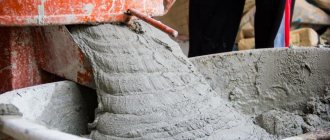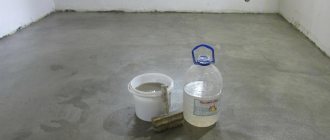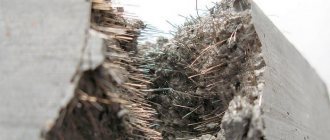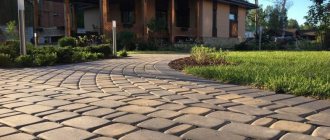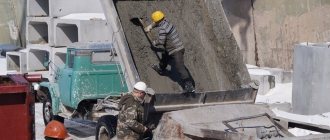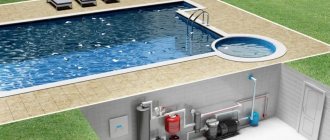Concrete is the bread of construction. Without it, no construction project can be completed; various structures and products are produced, from construction ones - foundations, walls, stairs - to decorative ones - benches, garden paths and small architectural forms. And all this is a simple mixture. True, the proportions of concrete and its characteristics can be very different - to perform different tasks.
Concrete is used to make large multi-storey buildings, paths and small sculptures. For this purpose, concrete of different compositions is used.
Concrete composition: components, their sizes and characteristics
Most concrete consists of three main components:
- The binder is most often cement, sometimes lime.
- Fillers - sand, crushed stone, pebbles.
- Water.
Different quantities of just three components give a wide range of qualities and characteristics. To impart special properties, various additives and additives are also used, which greatly expands the scope of use of this material.
All these brands of concrete are made from the same components, but in different proportions
The main characteristic of concrete is its strength or the load that it can withstand for a long time without losing its strength characteristics. This parameter is the key when choosing the grade of concrete for the foundation. Water permeability and frost resistance may also be important. But these are the characteristics of the “ripened” material, which depend on the recipe. And when kneading, you may be interested in such a characteristic as workability. It reflects the degree of concrete fluidity and depends on the amount of water in the composition. You can increase fluidity without adding water using additives, as well as increase frost resistance and water-repellent properties.
The strength of concrete depends on how accurately the recipe was followed, on the quality of the ingredients and on how thoroughly everything was mixed. Only with a homogeneous composition and high-quality components can design characteristics be achieved. Read more about what components can be used and the requirements for them at the end of the article.
Operating rules
Laying lean concrete will occur without problems and with high quality, if you follow the basic rules - they will help increase the durability of the structure and reduce repair costs. The standards are designed to eliminate the risk of deformation and cracking.
Basic Rules:
- At the installation stage, it is important to check and eliminate any defects from the surface.
- It is advisable to check the quality of materials in the laboratory, or at least visually evaluate the samples.
- To form a road surface, the following are always taken into account: the intensity of vehicle traffic, the type of vehicles, the strength of the main road surface, and the climatic parameters of the area. Most often, the thickness of the layer is 15 cm or less, but for routes with frequent truck traffic - 20 cm. Immediately after the road surface is laid, you can drive on it.
It is worth paying special attention to the installation of compression joints between the elements on the base and the concrete. It is better to create a distance of 15-20 cm. Cutting can be done only after the concrete has completely hardened. The depth is chosen to be about 25% of the total concrete thickness. The greatest attention should be paid to the edges; only after the compaction stage can you begin laying the main covering.
Like any other work, laying lean concrete is governed by certain rules.
The increase in the use of lean concrete occurs due to the low economic and time costs of installing lean concrete. To increase strength and resistance to destructive external influences, special additives are added to the composition, which are developed in laboratories and sold in stores.
A key way to increase strength is a vibrating roller; it compacts the concrete and increases its strength. Before vibration impacts on the coating, it is recommended to first roll over it with a roller - this will protect against damage to its integrity.
Principle of concrete marking
The main characteristics of concrete are its strength and compressive class. The compression class is indicated by the letter “B”, followed by class numbers from 3 to 40, the strength grade is indicated by the letter “M”, followed by numbers from 50 to 1000. They indicate the maximum load that this type of concrete can withstand. For example, the M300 brand means that the maximum load per 1 square centimeter cannot be higher than 300 kg.
In private construction, the most popular grades are M200-M250; for the foundations of two-story houses, M300-M350 concrete can be used; M400 is much less often poured - for heavy buildings on difficult soils. Higher ones are generally rare. Their area of application is industrial construction and objects with special properties (piers, dams, roads, etc.).
The correspondence between concrete grades in terms of strength and compression is given in the table (used in private construction).
| Concrete class by compressive strength | Compressive strength of concrete kg/cm2 | The closest concrete grade in terms of strength |
| AT 5 | 65.5 | M 75 |
| B 7.5 | 98.2 | M 100 |
| B 10 | 131.0 | M 150 |
| B 12.5 | 163.7 | M 150 |
| B 15 | 196.5 | M 200 |
| B 20 | 261.9 | M 250 |
| B 22.5 | 294.4 | M 300 |
| B 25 | 327.4 | M 350 |
| B 30 | 392.9 | M 400 |
| B 35 | 458.4 | M 450 |
| B 40 | 523.5 | M 500 |
Compaction factor
Like any material, lean concrete is prone to deformation. When installed correctly, it becomes strong and durable. Solutions of this type are laid using a vibrating plate or roller. This process is called compaction. It helps distribute the solution according to the chosen shape, improves the adhesion of all components and displaces unnecessary air.
The compaction coefficient of lean concrete laid according to the rules is most often 0.98-1. To improve the quality of the solution, it is necessary to use the optimal amount of water. Since the indicator of its content affects the density of the mixture.
When working in laboratories, specialists are able to correctly calculate this coefficient.
Proportions of concrete of different grades
This entire range and range of qualities is obtained by using the same materials, just in different quantities. To achieve the required characteristics, the recommended proportions must be strictly observed.
When building your house, you want to do everything as best as possible, and therefore, when making concrete, you want to add more cement to make it stronger. This should not be done. It's unlikely to get better, but it could easily get worse. To gain strength, concrete needs a certain amount of water and other components. If there is little water, there is a lot of cement, bonds between particles are formed in insufficient quantities, which is why the concrete can crack and crumble. The same applies to the number of fillers. Both their too high and insufficient content negatively affects the qualities of concrete stone.
Concrete proportions are usually displayed in fractions. The amount of cement is taken as a unit, and the remaining components are prescribed in relation to it. The data is presented in the form of tables for the corresponding brands; the units of measurement must be indicated. You can see such a table of concrete components below.
Proportions of concrete of different grades from Portland cement M400 and M500
How to determine the required proportions of concrete using this table? In the second column, find the required grade of concrete. For example, you need an M250. Depending on which Portland cement you will use M 400 or M 500, choose one of two lines. The third column shows the proportions for concrete in kilograms: for 400 cement it is 1/2.1/3.9. This means this: to obtain concrete grade M 250, for 1 kg of Portland cement M400 you need to add 2.1 kg of sand and 3.9 kg of crushed stone. Similarly, determine the proportions for concrete M200 - the data for it in the table is slightly higher, or concrete M 300 - slightly lower.
The fourth column presents volume fractions: all components are given per 10 liters. They are selected in the same way.
Such tables do not indicate the amount of water. It depends on how thick the solution is needed. The water-cement ratio is given in separate tables. For example, below are data on the number of inputs in relation to a kilogram of cement, provided that medium-sized aggregates are used.
The amount of water to obtain concrete of the required grade when using medium-sized crushed stone and sand
For example, to obtain concrete grade M 300, the proportions of cement M 500 and water are defined as 0.61. This means that for 1 kg of cement, 0.61 liters of water (610 ml) are added to the solution. This produces a medium-plastic solution, which is used most often. But when pouring foundations or other structures with dense reinforcement, a plastic solution may be needed. Then, when determining the amount of water, in addition to the brand of cement, it is also necessary to take into account the size of the aggregates and how fluid the solution should be. These data are presented in the table below.
The amount of water in concrete depending on the size of crushed stone/gravel and the fluidity of the solution
Sometimes it is necessary to determine how much cement you will need for a particular task. To do this, you need to know how much cement is contained in a cubic meter of concrete. Data on concrete and cement grades can be found in the table below.
Amount of cement per cube of concrete
Amount of water for different degrees of plasticity
When preparing a concrete mixture, liquid is added according to the norm. Both excess and insufficient moisture are harmful to the finished product.
Table No. 2 Water norm in liters per cubic meter with different fillers
| Plastic | Water with gravel (l.) | Water with crushed stone (l.) | ||||||
| Material fraction, mm (gravel) | Material fraction, mm (crushed stone) | |||||||
| 10 | 20 | 40 | 80 | 10 | 20 | 40 | 80 | |
| Maximum | 214 | 199 | 184 | 169 | 229 | 214 | 199 | 184 |
| Average | 204 | 189 | 174 | 159 | 219 | 204 | 189 | 174 |
| Minimum | 194 | 179 | 164 | 149 | 209 | 194 | 179 | 164 |
| Not plastic | 184 | 169 | 154 | 139 | 199 | 184 | 169 | 154 |
The plasticity of a material in everyday life can be determined by a simple test. Very plastic concrete flows easily from a shovel if the mixture floats when the tool is slightly tilted - this is medium-plastic concrete.
With low plasticity, the concrete mixture will not flow even with a strong slope. Material lying in a dense pile on a shovel is considered to have no plasticity.
Areas of use
We have decided what materials are required for concrete in what proportions, but what brand is needed? This depends on the purpose of the structure and its operating conditions. It will be easier to navigate if you know which grades of concrete can be used for what (let’s name only those that are used in the construction of a private house, its renovation or landscaping).
M100 (B7.5). This is the so-called lean concrete. It is used to prepare sites for critical structures. For example, when building a strip foundation, a layer of lean concrete is laid on a gravel-sand backfill, and then reinforcement work begins. The same composition is used when laying curb stones, for example, when making paths or blind areas around the house.
M150 (B12.5). This composition is used in preparation for slab foundations, for screeds, pouring concrete floors or garden paths. This type of concrete can be used to make foundations for small lightweight buildings such as a wooden bathhouse or a small guest house made of timber or logs.
M200 (B15). One of the most popular brands of concrete. It is used to make foundations of any type for light houses on normal soils, screeds, stairs, blind areas, paths. Cement blocks are made from this brand of concrete at home, and it is also used in factories for the production of foundation and building blocks.
Read about how to build your own foundation from FBS blocks here.
The ratio of cement and sand for concrete affects the strength characteristics
M250 (B20). The scope of application is almost the same, but in more difficult conditions. They make any foundations on difficult soils, or on normal ones, but for houses built from heavy materials. They make blind areas that will be used as paths, external stairs, concrete porches, fences, etc. It is also used to make floor slabs for light loads.
M300 (B22.5). Also suitable for all areas listed above, but under even more severe operating conditions. They make foundations for heavy houses on heaving soils, make monolithic walls, paths, waterproof blind areas, etc. This brand of concrete is mainly used to make floor slabs and grillages for pile-grillage foundations.
M350 (B25). The strength of this brand for private construction is generally excessive. This concrete is used for the construction of monolithic pool bowls or for the manufacture of foundations at high groundwater levels, for other structures that require high water resistance. This brand is already more often used in industrial construction.
M400 (B30). This is already an expensive brand of concrete, which is used in facilities with special requirements: for large swimming pools, dams, bank storage facilities, etc.
Recommendations
In modern construction, many types of concrete are used, each with its own characteristics. First, you should learn about lightweight types of concrete, namely, what expanded clay concrete and aerated concrete are.
- Autoclaved aerated concrete blocks are a mixture of concrete processed in autoclaves at high temperature and pressure. The end result is a durable, high-quality and reliable material made from environmentally friendly raw materials.
- Expanded clay concrete for flooring is characterized by low weight, sufficient strength, and increased thermal insulation and sound insulation qualities. With the listed advantages, it has a low price. The proportions of expanded clay concrete for screeds and floors are determined individually, taking into account the load on the base.
Concrete structures are prone to destruction in the absence of a metal base. Metal mesh for concrete reinforcement will increase the durability and strength of the structure.
A new type of concrete with fiber reinforcement is fiber-reinforced concrete. It is easier to consider what fiber-reinforced concrete is when determining its technical characteristics. With a low weight, it has relatively high strength, since reinforcing fiber or fiber is added to the composition.
Preparation of concrete
For large volumes of work, it is better to order concrete from the factory. Making large quantities of mortar by hand or even using concrete mixers is a difficult task, and laying it in batches requires additional effort to ensure that the layers adhere well. However, you can prepare concrete manually. In this case, there are two sequences of actions:
- First, concrete and sand are mixed dry. It is mixed until the color becomes uniform. Then crushed stone is poured in, everything is mixed again, and water is added last.
- First, water is poured into it and cement is poured into it. When everything is mixed, add sand and then coarse aggregate.
The order of adding components for concrete during mixing may be different.
In the first option, there is a possibility that during manual mixing, unmixed composition will remain at the bottom, near the walls of the container, which will lead to a decrease in the strength of the concrete. The solution is to mix everything well and thoroughly. But you can’t spend too much time on this: the solution will begin to set.
The second option has its disadvantages: obtaining a homogeneous cement laitance (a mixture of water and cement) sometimes takes a lot of time. As a result, there is simply not enough of it to form bonds with the backfill: the cement “seizes” and the strength of the concrete also decreases.
All this is not so critical when using concrete mixers, but it is also not ideal. There is another difficulty here. Concrete is usually delivered to the construction site in carts. The entire volume does not fit into one, and the remainder is left to spin in a concrete mixer. This is better than leaving it just standing, but if you mix it too long, the solution may begin to delaminate, resulting in lower concrete strength. The solution is two carts and two people to carry them. The filling method - first or second - choose for yourself.
For small volumes, concrete can be mixed by hand
So after all, how to prepare concrete. The choice is yours. If the volumes are small, you can knead by hand. Just do it carefully. To pour the foundation, it is better to order a mixer, but you can also use a concrete mixer (or two, depending on the volume). And to solve problems with the heterogeneity of the mixture (although it is better that it is good), treat the concrete being laid with a vibrator. Most of the problems will go away.
Next, we’ll talk about the requirements for concrete components, their sizes and qualities.
Laying
Working with the composition is relatively simple; the builder is not required to have knowledge or skills.
Installation procedure:
You should find a place to mix the cement mortar or use a concrete mixer. Sand is poured onto the surface and cement on top. Use a shovel, trowel, rake or any convenient tool to thoroughly mix the layers. Water is added to the dry mixture and the mixture is compacted.
The process of working with lean concrete is quite simple and does not require any special skills or knowledge.
Prepare the base where concrete is planned to be laid. It is recommended to make a recess 10 cm lower than the planned burial level. This is important for the possibility of installing the reinforcement cage. If you reduce the pouring depth, you will be able to reduce the cost of solution and time.
Requirements for cements for concrete
For most construction work, cement concrete is used, where Portland cement is used as a binding component. There is also limestone, but its scope of application is limited mainly to finishing work, which is done “the old fashioned way.”
Types of Portland cement and their storage
There are several types of Portland cement: Portland slag cement, aluminous cement and pozzolanic cement. They all differ slightly in characteristics, but any are suitable for private construction. The difference can only affect the setting time: slag Portland cement takes the longest to harden - up to 12 hours, followed by standard Portland cement - up to 10 hours, and aluminous binder hardens the fastest - no more than 8 hours.
Cement for concrete must be dry, free-flowing and fresh
Cement is demanding on storage conditions, and especially humidity. For the manufacture of important structures - foundations, floors, etc. It is advisable to use fresh one, recently released from the factory. Within a month it loses up to 10% of its properties, and after 6 months they deteriorate by 30-35%. Therefore, for example, when pouring a foundation, it is better to take it a maximum of two weeks ago and purchase it shortly before use.
Store in a dry, ventilated area. If there is no room, they are stored under a roof or wrapped in several layers of film to protect them from moisture. Please note - wrapped, not covered. And preferably not on the ground, but on a wooden floor. The thing is that when moisture gets in, even in a vapor state, the cement becomes lumpy, which greatly worsens the characteristics of concrete. If there is an abundance of moisture, it simply becomes a stone and there is no way to use it. Therefore, take care of a place to store cement in advance.
Cement marking
What brand of cement should be used is usually indicated in the concrete recipe. It is designated by the letter M and numbers that indicate the maximum concrete strength that can be achieved with this binder. For example, with M400 grade cement you can get maximum concrete grade M400, as well as lower ones.
Next comes the letter “D” and numbers indicating the amount of impurities. M400 D15, means that there are 15% impurities in the binder. For construction work, this figure should not be more than 20%.
Specifics of masonry
Laying the material requires preparing the base, which must be leveled and a sand cushion formed. A recess below the zero level of the working site will allow you to install a reinforcing mesh and fill the cavity with lean concrete to the soil level. The duration of hardening of the massif is influenced by weather conditions.
When deciding on the brand of solution, take into account the size of the load, traffic intensity, soil characteristics, and climatic factors. The use of vibration compaction allows compacting lean concrete, which increases the strength of the mass and reduces the likelihood of cracks.
The ratio of components for preparing the mixture depends on the selected brand of cement
Fillers - crushed stone and sand
The composition of concrete is determined by the functions and characteristics of concrete that are necessary during its operation. The most common are sand and crushed stone. They are subject to no less stringent requirements than the quality of cement. Sometimes pebbles are used, but only if they have sharp edges and not round ones. In the presence of broken lines, the adhesion of the aggregate to the solution is better, as a result, the strength of the concrete is much higher.
Sand
Construction sand can be river or quarry sand. River water is more expensive, but it is usually cleaner and has a more uniform structure. It is best used when preparing concrete for pouring foundations and screeds. For masonry or plastering, it is appropriate to use cheaper quarry sand.
In addition to its origin, sand is distinguished by fractions. For construction work, large or medium ones are used. Small and dusty ones are not suitable. The normal size of sand grains is from 1.5 mm to 5 mm. But optimally in solution it should be more homogeneous, with a difference in grain size of 1-2 mm.
The sand must be clean, preferably with the same grain sizes
The cleanliness of the sand is also important. It should definitely not contain any foreign organic inclusions - roots, stones, pieces of clay, etc. Even the dust content is standardized. For example, when mixing concrete for a foundation, the amount of contamination should not exceed 5%. This is determined empirically. 300 ml of sand is poured into a half-liter container, everything is filled with water. After a minute, when the grains of sand settle, the water is drained and refilled. This is repeated until it is transparent. After this, determine how much sand is left. If the difference is no more than 5%, the sand is clean and can be used when mixing concrete for the foundation.
For those jobs where the presence of clay or lime is only a plus - when laying or plastering - there is no need to take special care of the cleanliness of the sand. There should be no organic matter or stones, and the presence of clay or lime dust will only make the solution more plastic.
Crushed stone
For critical structures - floors and foundations - crushed crushed stone is used. It has sharp edges that adhere better to the mortar, giving the structure greater strength.
Crushed stone fractions are standard:
- extra small 3-10 mm;
- small 10-12 mm;
- average 20-40 mm;
- large 40-70 mm.
In the batch, crushed stone is used in several fractions - from small to coarse
Several different fractions are used simultaneously in concrete. The largest fragment should not exceed 1/3 the size of the smallest element of the structure being poured. Let me explain. If a reinforced foundation is being poured, then the structural element that is taken into account is the reinforcement. Find the two elements closest to each other. The largest stone should not be more than 1/3 of this distance. In the case of pouring a blind area, the smallest size is the thickness of the concrete layer. Choose crushed stone so that it is no more than a third of its thickness.
Fine crushed stone should be about 30%. The remaining volume is divided between medium and large in arbitrary proportions. Pay attention to the dustiness of the crushed stone. Lime dust is especially undesirable. If there is a lot of it, the crushed stone is washed, then dried, and only then poured into concrete.
Aggregate storage
It is clear that a construction site is not the cleanest and most organized place, and sand and crushed stone are often dumped directly onto the ground. In this case, when loading, you must ensure that no soil gets into the mix. Even a small amount will negatively affect the quality. Therefore, it is advisable to pour aggregates onto solid areas.
It is also necessary to protect them from precipitation. In concrete formulations, the number of components is given based on dry components. You learn to take into account the moisture content of components with experience. If you don’t have one, you have to take care of the condition and cover the sand and gravel from rain and dew.
Conclusion
- Concrete is a mixture of cement, sand and crushed stone. The plasticity of the solution is achieved by moistening the dry mixture.
- Today there are many types of concrete mortar created without “intermediaries” in the composition. This allows you to expand the scope of application of the material and give it additional properties.
- To make concrete strong enough, you need to choose the right grade of cement, as well as the fraction of ballast components. The universal proportion for small construction and repair work is 1:6.
- As an alternative to formwork, geotextile film can be used to construct the foundation. It allows you to maintain the moisture content of the solution and the required shape.
Transportation Features
The most cost-effective and simplest method of transportation is transportation using a dump truck, due to the long setting time of the solution. During transportation, it is very important to ensure the correct temperature and humidity conditions to protect the concrete from excessive waterlogging or drying out. If the conditions are not met, the quality of the building material may deteriorate.
It is best to order ready-mixed concrete from manufacturers, as they maintain precise proportions of components using automatic weighing. When mixing the ingredients, special mixers are used that have a continuous or cyclic mixing action. To obtain a homogeneous mixture without delamination, concrete mixers are equipped with storage hoppers.
